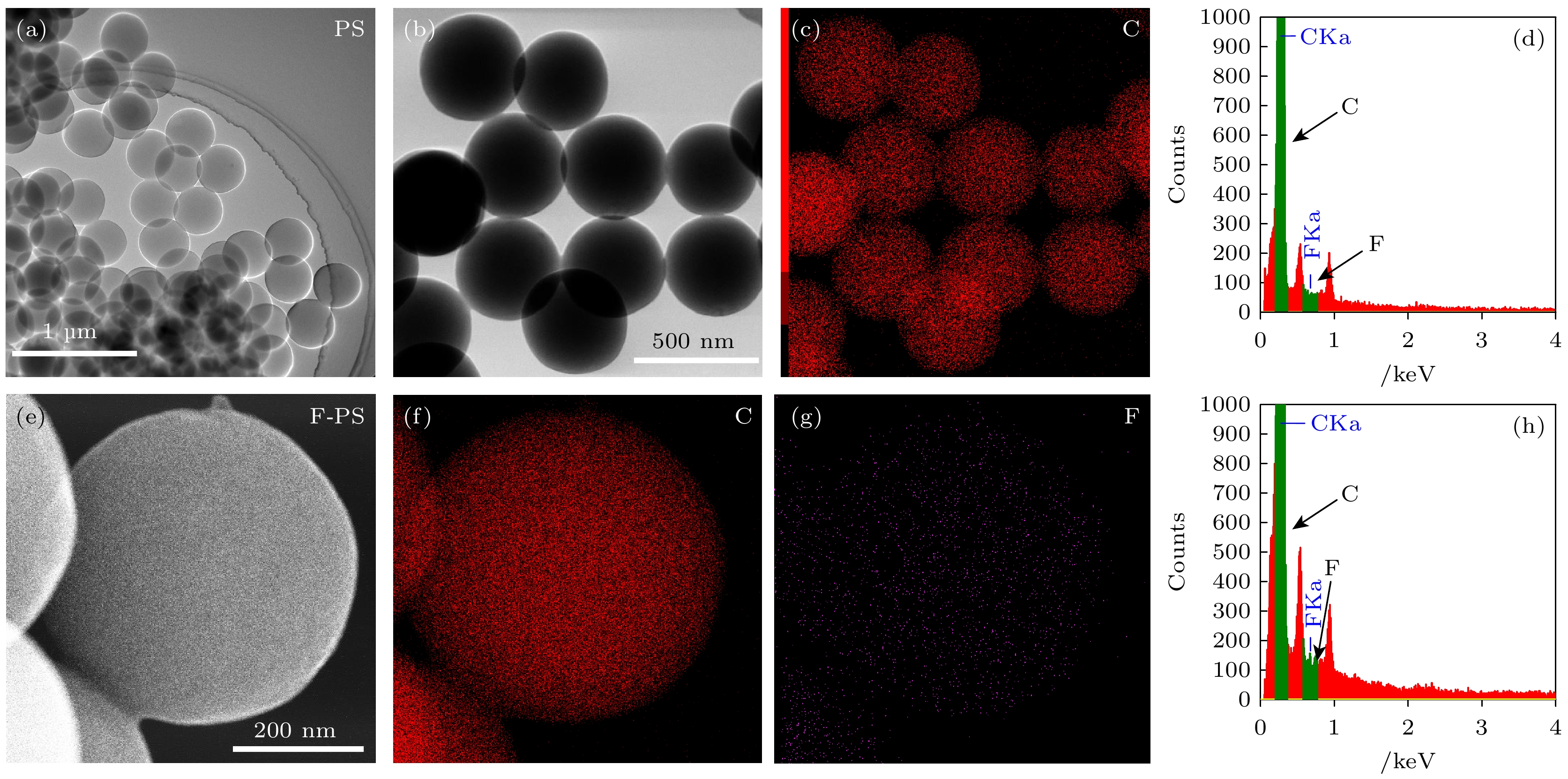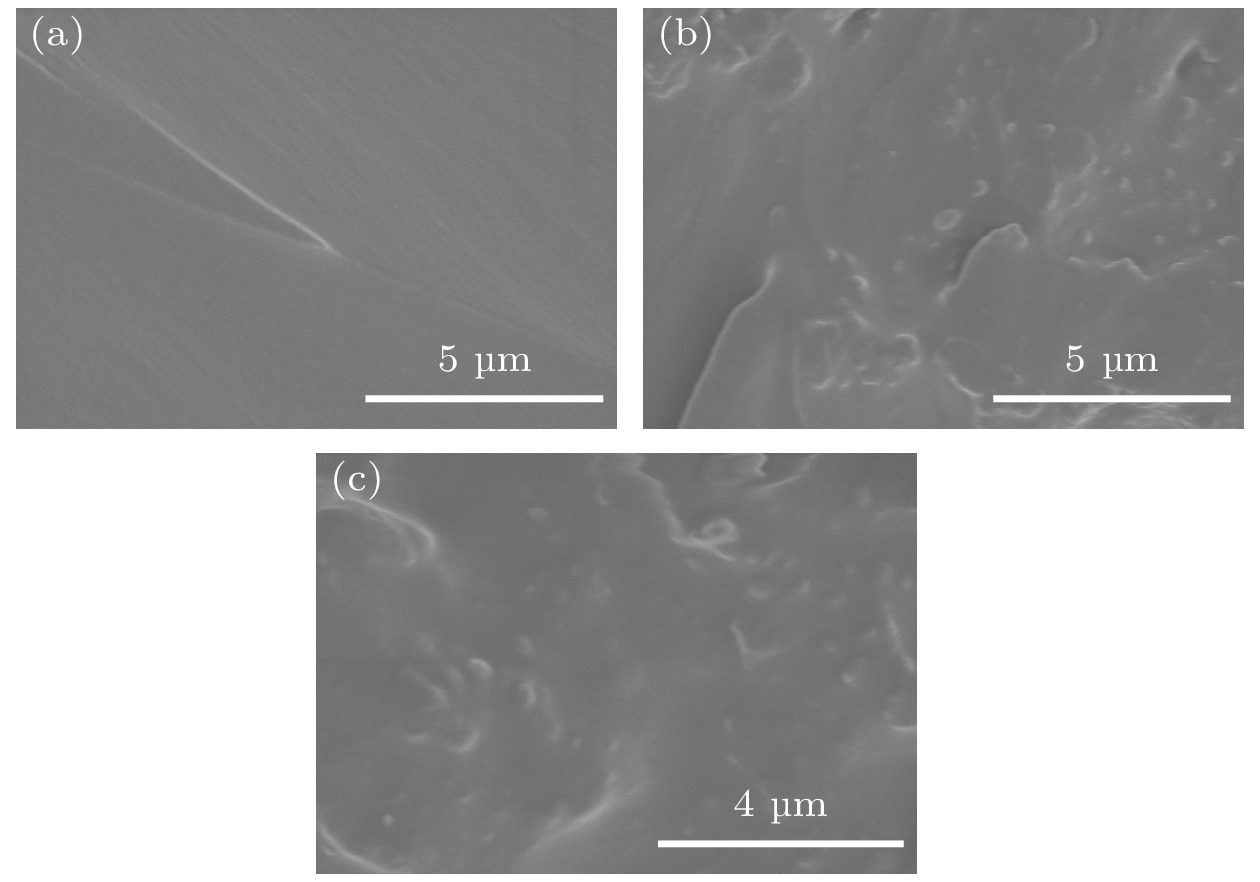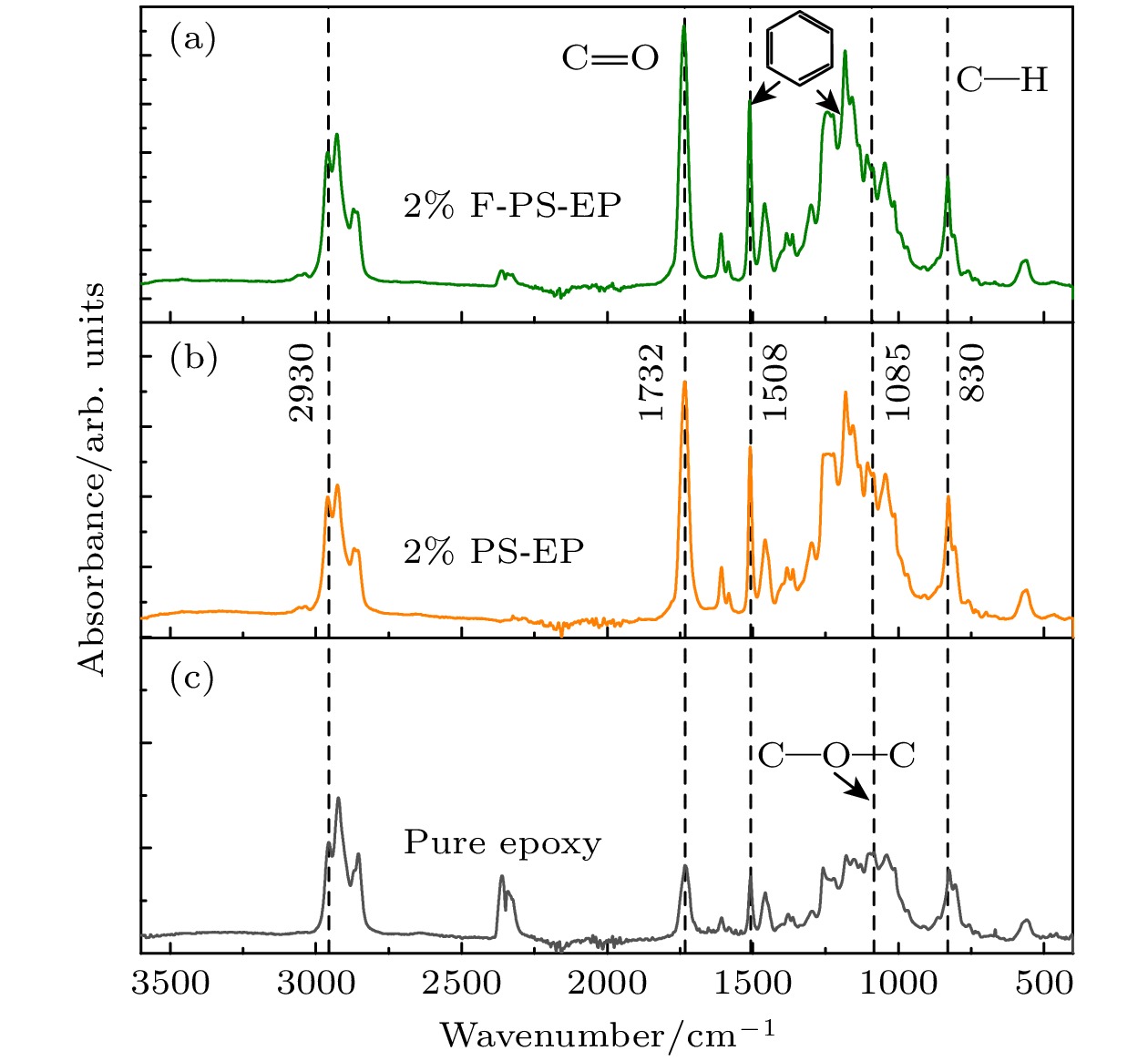-
环氧树脂纳米复合材料在电气绝缘领域应用广泛, 通过引入纳米介质实现复合材料介电、绝缘性能的调控以满足特殊应用需求. 本文通过五氟苯乙烯与苯乙烯的共聚, 制备了表面氟化的聚苯乙烯纳米微球, 并以其为填料制备了环氧树脂复合材料. 以纯环氧树脂和填充聚苯乙烯纳米微球环氧复合材料作为参照, 研究了三种复合材料的直流电导率、介电特性、交直流击穿场强、空间电荷行为并计算了材料内部的陷阱能级. 结果表明: 填充氟化聚苯乙烯纳米微球的环氧树脂复合材料表现出优异的电学特性, 其电导率以及介电常数大幅下降、同时交直流击穿场强获得提高. 相比填充无氟聚苯乙烯纳米微球的环氧树脂, 氟化聚苯乙烯纳米微球的引入可降低材料的介电损耗, 限制空间电荷的注入, 并加深基体中的陷阱能级. 研究结果可为环氧树脂复合材料介电性能调控设计以及环氧树脂在电子封装应用提供指导.
Epoxy resin nanocomposites are widely used in the field of electrical insulation packaging. It is of great significance to regulate the dielectric and insulation properties of composite materials by introducing nano-filler to meet special application requirements. This work proposes a chemical copolymerization method, fluorinated polystyrene nanospheres are synthesized through an addition reaction as filler, and finally the epoxy nanocomposites are prepared. The polystyrene nanospheres have a uniform size and good compatibility with the epoxy resin. The introducing of nanospheres reduces the dielectric constant of the epoxy resin composite material and increases the breakdown strength simultaneously. Although the dielectric loss increases, the composites’ imaginary part remains below 0.04 within 1 MHz frequency. In particular, the fluorinated polystyrene/epoxy composite with a mass fraction of 2% exhibits a decrease in dielectric constant and DC conductivity, while the AC breakdown strength and DC breakdown strength increase by 12.6% and 6%, respectively. The results of the pulse electro-acoustic method indicate that the charge injection of the epoxy resin filled with non-fluorinated polystyrene nanospheres is evident, while the introduction of fluorinated nanospheres significantly reduces the charge injection level. Calculations based on the depolarization process reveal that the introduction of fillers leads to an increase in trap density and depth of energy levels in the composites. Notably, the epoxy resin filled with fluorinated fillers has the deepest trap levels, providing an explanation for the improved insulation breakdown performance. The research can provide guidance for regulating dielectric properties of epoxy composites and material synthesis for the application of electrical insulation packaging . -
Keywords:
- epoxy resin /
- PS nanospheres /
- fluorination /
- dielectric properties
[1] Lewis T J 1994 IEEE Trans. Dielectr. Electr. Insul. 1 812
 Google Scholar
Google Scholar
[2] Wang Y H, Chen Z, Li J, Liu Z X, Chen R, Aung H H, Liang H C, Du B X 2024 IET Nanodielectrics 7 26
 Google Scholar
Google Scholar
[3] Zheng H B, Li Y H, Luo X Q, Zhang E Z, Jing J X 2023 IEEE Trans. Dielectr. Electr. Insul. 30 1884
 Google Scholar
Google Scholar
[4] Shen K D, Zhang X L, Qin H M, Ding C W, Nie X X, Chen D, Fan R, Xiong C X 2024 J. Mater. Sci. -Mater. Electron. 35 21
 Google Scholar
Google Scholar
[5] 刘秀成, 杨智, 郭浩, 陈颖, 罗向龙, 陈健勇 2023 72 168102
 Google Scholar
Google Scholar
Liu X C, Yang Z, Guo H, Chen Y, Luo X L, Chen J Y 2023 Acta Phys. Sin. 72 168102
 Google Scholar
Google Scholar
[6] Dong X D, Wan B Q, Qiu L, Zheng M S, Gao J F, Zha J W 2022 IET Nanodielectrics 6 76
 Google Scholar
Google Scholar
[7] Abusaleh B A, Elimat Z M, Alzubi R I, Juwhari H K 2023 J. Compos. Sci. 7 254
 Google Scholar
Google Scholar
[8] 刘曰利, 赵思杰, 陈文, 周静 2022 71 210201
 Google Scholar
Google Scholar
Liu Y L, Zhao S J, Chen W, Zhou J 2022 Acta Phys. Sin. 71 210201
 Google Scholar
Google Scholar
[9] 任俊文, 姜国庆, 陈志杰, 魏华超, 赵莉华, 贾申利 2024 73 027703
 Google Scholar
Google Scholar
Ren J W, Jiang G Q, Chen Z J, Wei H C, Zhao L H, Jia S L 2024 Acta Phys. Sin. 73 027703
 Google Scholar
Google Scholar
[10] Li M R, Shang K, Zhao J H, Jiang L H, Sun J P, Wang X, Niu H, Feng Y, An Z L, Li S T 2023 ACS Appl. Polym. Mater. 5 10226
 Google Scholar
Google Scholar
[11] Lü F C, Ruan H O, Song J X, Yin K, Zhan Z Y, Jiao Y F, Xie Q 2019 J. Phys. D: Appl. Phys. 52 155201
 Google Scholar
Google Scholar
[12] Ruan H O, Xie Q, Lü F C, Zhan Z Y, Yan J Y, Hao L C, Zhu Q S 2020 J. Phys. D: Appl. Phys. 53 145204
 Google Scholar
Google Scholar
[13] 杨国清, 刘阳, 戚相成, 王德意, 王闯, 曾庆文 2021 高电压技术 47 3144
 Google Scholar
Google Scholar
Yang G Q, Liu Y, Qi X C, Wang D Y, Wang C, Zeng Q W 2021 High Voltage Eng. 47 3144
 Google Scholar
Google Scholar
[14] Duan Q J, Song Y Z, Shao S, Yin G H, Ruan H O, Xie Q 2023 Plasma Sci. Technol. 25 104004
 Google Scholar
Google Scholar
[15] Zhang C, Ma Y Y, Kong F, Yan P, Chang C, Shao T 2019 Surf. Coat. Technol. 362 1
 Google Scholar
Google Scholar
[16] 查俊伟, 查磊军, 郑明胜 2023 72 018401
 Google Scholar
Google Scholar
Zha J W, Zha L J, Zheng M S 2023 Acta Phys. Sin. 72 018401
 Google Scholar
Google Scholar
[17] Wei W C, Chen H Q, Zha J W, Zhang Y Y 2023 Front. Chem. Sci. Eng. 17 991
 Google Scholar
Google Scholar
[18] Liu Y P, Li L, Liu H C, Zhang M J, Liu A J, Liu L, Tang L, Wang G L, Zhou S S 2020 Compos. Sci. Technol. 200 108418
 Google Scholar
Google Scholar
[19] Liu Y Y, Yao R X, Tong Y J, Lu Y Q, Guo Q Y 2023 Polym. Bull. DOI: 10.1007/s00289-023-05120-w
[20] 高铭泽, 张沛红 2016 65 247802
 Google Scholar
Google Scholar
Gao M Z, Zhang P H 2016 Acta Phys. Sin. 65 247802
 Google Scholar
Google Scholar
[21] Zhu G, Chen X, Hong Z, Awais M, Paramane A, Wang X, Zhang J Q, Liu W 2022 IEEE Trans. Appl. Supercond. 32 1
 Google Scholar
Google Scholar
[22] Turgeman R, Gershevitz O, Palchik O, Deutsch M, Ocko B M, Gedanken A, Sukenik C N 2004 Cryst. Growth 4 169
 Google Scholar
Google Scholar
[23] Shang X J, Zhu Y M, Li Z H 2017 Appl. Surf. Sci. 394 169
 Google Scholar
Google Scholar
[24] Su Y C, Chang F C 2003 Polymer 44 7989
 Google Scholar
Google Scholar
[25] 陈季丹, 刘子玉 1982 电介质物理学(北京: 机械工业出版社) 第94页
Chen J D, Liu Z Y 1982 Dielectric Physics (Beijing: China Machine Press) p94
[26] Lin Y, Liu Y, Cao B, Xue J, Wang L, Wang J, Ding L 2023 High Voltage 8 283
 Google Scholar
Google Scholar
[27] 周远翔, 黄猛, 陈维江, 孙清华, 沙彦超, 张灵 2013 高电压技术 39 1304
 Google Scholar
Google Scholar
Zhou Y X, Huang M, Chen W J, Sun Q H, Sha Y C, Zhang L 2013 High Voltage Eng. 39 1304
 Google Scholar
Google Scholar
[28] Simmons J G, Tam M C 1973 Phys. Rev. B 7 3706
 Google Scholar
Google Scholar
[29] Xie Q, Yin G H, Duan Q J, Zhong Y Y, Xie J, Fu K X, Wang P 2023 Polym. Compos. 44 6071
 Google Scholar
Google Scholar
[30] Chen X, Yu J, Yu L, Zhou H 2018 IEEE Access 7 8226
 Google Scholar
Google Scholar
-
图 1 PS, F-PS纳米微球及表面C, F元素分布 (a), (b)不同窗口尺寸下的PS纳米微球形貌; (c) PS纳米微球表面C元素分布; (d) PS纳米微球C和F元素含量; (e) F-PS纳米微球形貌; (f), (g) F-PS纳米微球表面C和F元素分布; (h) F-PS纳米微球表面C和F元素含量
Fig. 1. PS and F-PS nanospheres and C, F element distribution: (a), (b) Morphology of PS nanospheres at different zoom scale; (c) distribution of C element on the surface of PS nanospheres; (d) the content of C and F elements in PS nanospheres; (e) morphology of F-PS nanospheres; (f), (g) distribution of C and F elements on the surface of F-PS nanospheres; (h) content of C and F elements in F-PS nanospheres.
图 6 复合材料宽频介电常数(a)实部ε'和虚部ε''; (b) Pure EP, (c) 2% PS-EP和(d) 2% F-PS-EP介电虚部弛豫响应分解
Fig. 6. Broadband dielectric spectroscopy (a) real part ε' and imaginary part ε'' of composites; the fitting data of broadband dielectric spectroscopy imaginary part ε'' corresponds to (b) Pure EP, (c) 2% PS-EP, (d) 2% F-PS-EP composites.
表 1 Pure EP, PS-EP和F-PS-EP韦布尔概率分布参数
Table 1. Weibull distribution parameters for Pure EP, PS-EP and F-PS-EP.
复合材料 AC DC μ σ μ σ Pure EP 67.45 5.00 187.20 24.63 2% PS-EP 74.00 4.02 190.41 32.18 2% F-PS-EP 75.54 3.99 198.59 25.20 -
[1] Lewis T J 1994 IEEE Trans. Dielectr. Electr. Insul. 1 812
 Google Scholar
Google Scholar
[2] Wang Y H, Chen Z, Li J, Liu Z X, Chen R, Aung H H, Liang H C, Du B X 2024 IET Nanodielectrics 7 26
 Google Scholar
Google Scholar
[3] Zheng H B, Li Y H, Luo X Q, Zhang E Z, Jing J X 2023 IEEE Trans. Dielectr. Electr. Insul. 30 1884
 Google Scholar
Google Scholar
[4] Shen K D, Zhang X L, Qin H M, Ding C W, Nie X X, Chen D, Fan R, Xiong C X 2024 J. Mater. Sci. -Mater. Electron. 35 21
 Google Scholar
Google Scholar
[5] 刘秀成, 杨智, 郭浩, 陈颖, 罗向龙, 陈健勇 2023 72 168102
 Google Scholar
Google Scholar
Liu X C, Yang Z, Guo H, Chen Y, Luo X L, Chen J Y 2023 Acta Phys. Sin. 72 168102
 Google Scholar
Google Scholar
[6] Dong X D, Wan B Q, Qiu L, Zheng M S, Gao J F, Zha J W 2022 IET Nanodielectrics 6 76
 Google Scholar
Google Scholar
[7] Abusaleh B A, Elimat Z M, Alzubi R I, Juwhari H K 2023 J. Compos. Sci. 7 254
 Google Scholar
Google Scholar
[8] 刘曰利, 赵思杰, 陈文, 周静 2022 71 210201
 Google Scholar
Google Scholar
Liu Y L, Zhao S J, Chen W, Zhou J 2022 Acta Phys. Sin. 71 210201
 Google Scholar
Google Scholar
[9] 任俊文, 姜国庆, 陈志杰, 魏华超, 赵莉华, 贾申利 2024 73 027703
 Google Scholar
Google Scholar
Ren J W, Jiang G Q, Chen Z J, Wei H C, Zhao L H, Jia S L 2024 Acta Phys. Sin. 73 027703
 Google Scholar
Google Scholar
[10] Li M R, Shang K, Zhao J H, Jiang L H, Sun J P, Wang X, Niu H, Feng Y, An Z L, Li S T 2023 ACS Appl. Polym. Mater. 5 10226
 Google Scholar
Google Scholar
[11] Lü F C, Ruan H O, Song J X, Yin K, Zhan Z Y, Jiao Y F, Xie Q 2019 J. Phys. D: Appl. Phys. 52 155201
 Google Scholar
Google Scholar
[12] Ruan H O, Xie Q, Lü F C, Zhan Z Y, Yan J Y, Hao L C, Zhu Q S 2020 J. Phys. D: Appl. Phys. 53 145204
 Google Scholar
Google Scholar
[13] 杨国清, 刘阳, 戚相成, 王德意, 王闯, 曾庆文 2021 高电压技术 47 3144
 Google Scholar
Google Scholar
Yang G Q, Liu Y, Qi X C, Wang D Y, Wang C, Zeng Q W 2021 High Voltage Eng. 47 3144
 Google Scholar
Google Scholar
[14] Duan Q J, Song Y Z, Shao S, Yin G H, Ruan H O, Xie Q 2023 Plasma Sci. Technol. 25 104004
 Google Scholar
Google Scholar
[15] Zhang C, Ma Y Y, Kong F, Yan P, Chang C, Shao T 2019 Surf. Coat. Technol. 362 1
 Google Scholar
Google Scholar
[16] 查俊伟, 查磊军, 郑明胜 2023 72 018401
 Google Scholar
Google Scholar
Zha J W, Zha L J, Zheng M S 2023 Acta Phys. Sin. 72 018401
 Google Scholar
Google Scholar
[17] Wei W C, Chen H Q, Zha J W, Zhang Y Y 2023 Front. Chem. Sci. Eng. 17 991
 Google Scholar
Google Scholar
[18] Liu Y P, Li L, Liu H C, Zhang M J, Liu A J, Liu L, Tang L, Wang G L, Zhou S S 2020 Compos. Sci. Technol. 200 108418
 Google Scholar
Google Scholar
[19] Liu Y Y, Yao R X, Tong Y J, Lu Y Q, Guo Q Y 2023 Polym. Bull. DOI: 10.1007/s00289-023-05120-w
[20] 高铭泽, 张沛红 2016 65 247802
 Google Scholar
Google Scholar
Gao M Z, Zhang P H 2016 Acta Phys. Sin. 65 247802
 Google Scholar
Google Scholar
[21] Zhu G, Chen X, Hong Z, Awais M, Paramane A, Wang X, Zhang J Q, Liu W 2022 IEEE Trans. Appl. Supercond. 32 1
 Google Scholar
Google Scholar
[22] Turgeman R, Gershevitz O, Palchik O, Deutsch M, Ocko B M, Gedanken A, Sukenik C N 2004 Cryst. Growth 4 169
 Google Scholar
Google Scholar
[23] Shang X J, Zhu Y M, Li Z H 2017 Appl. Surf. Sci. 394 169
 Google Scholar
Google Scholar
[24] Su Y C, Chang F C 2003 Polymer 44 7989
 Google Scholar
Google Scholar
[25] 陈季丹, 刘子玉 1982 电介质物理学(北京: 机械工业出版社) 第94页
Chen J D, Liu Z Y 1982 Dielectric Physics (Beijing: China Machine Press) p94
[26] Lin Y, Liu Y, Cao B, Xue J, Wang L, Wang J, Ding L 2023 High Voltage 8 283
 Google Scholar
Google Scholar
[27] 周远翔, 黄猛, 陈维江, 孙清华, 沙彦超, 张灵 2013 高电压技术 39 1304
 Google Scholar
Google Scholar
Zhou Y X, Huang M, Chen W J, Sun Q H, Sha Y C, Zhang L 2013 High Voltage Eng. 39 1304
 Google Scholar
Google Scholar
[28] Simmons J G, Tam M C 1973 Phys. Rev. B 7 3706
 Google Scholar
Google Scholar
[29] Xie Q, Yin G H, Duan Q J, Zhong Y Y, Xie J, Fu K X, Wang P 2023 Polym. Compos. 44 6071
 Google Scholar
Google Scholar
[30] Chen X, Yu J, Yu L, Zhou H 2018 IEEE Access 7 8226
 Google Scholar
Google Scholar
计量
- 文章访问数: 6204
- PDF下载量: 144
- 被引次数: 0














 下载:
下载:








